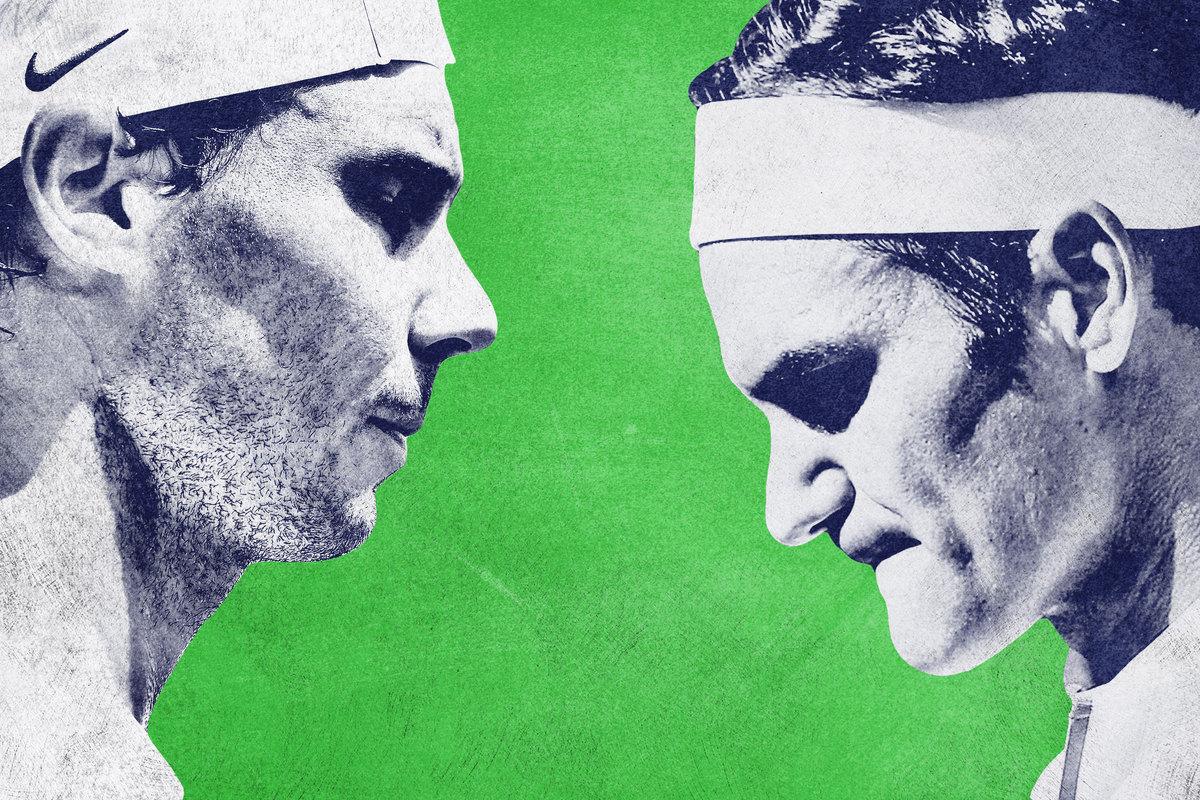
This past weekend, faced with the near-total cessation of live sports in the wake of the coronavirus crisis, ESPN2 did something historically unprecedented for an ESPN property in early spring. It aired 22 consecutive hours of tennis. The marathon, which featured six classic Grand Slam matches between Rafael Nadal and Roger Federer, reflected what’s become a standard fallback strategy for sports broadcasters coping with the disappearance of their entire content stream: namely, that when you can’t show the thing you meant to show, replaying old hits can be a good way to fill dead air. The Australian Open men’s semifinals from eight years ago might not be the first weekend of the MLB season, but it’s better than static in a pinch.
This is an understandable strategy, but it creates a bizarre effect. The quality of the games on TV wildly improves, even as the level of drama they conjure nosedives. The choreography gets better and the stakes vanish. In terms of pure athletic brilliance, the Federer-Nadal marathon might have represented the best sustained 22-hour programming block in the history of Bristol, Connecticut; in terms of visceral excitement, though, it fell somewhere below an early-round match in a clay-court warm-up tournament. Sports lives in the uncertain moment, in the mystery of what happens next. A beautiful shot may be beautiful forever, but take away the unpredictability of the struggle that provokes it, and you’re left with half an experience. (If this weren’t the case, we’d watch greatest hits matches as readily as we watched new ones.) Tuning into old sporting events in their entirety often has the odd, de-escalated quaintness of a trip to the natural history museum: It’s not the same when you know the tiger can’t eat you.
Still, at a moment when many people are at home and looking for something to get lost in, a full day of Federer-Nadal—one of the greatest rivalries in sports history, featuring some of the best matches ever played—will never be the worst show on television. And so there they were, for the length of two full seasons of a Netflix drama, reminding the viewing audience why they’ve meant so much to the sports world for so long. There was Federer winning five straight games to come back from 3-1 down in the final set of the 2017 Australian Open final. There was Nadal, in the 2007 Wimbledon final—probably the final tournament when he was seen as Federer’s clear inferior away from clay courts—crushing deep winners past Roger on the way to winning the fourth set, which seemed like a startling upset at the time. And there they both were, in what’s often called the best tennis match ever played, the 2008 Wimbledon final, trading a seemingly limitless series of astonishing shots as darkness fell on Centre Court.
I thought about these moments on Wednesday when the All England Lawn Tennis & Croquet Club announced the cancelation of Wimbledon due to the ongoing public health crisis. The TV marathon had run only a little ahead of the news, tennis being called on to fill hours of dead air shortly before more hours of dead air were created by tennis. Wimbledon’s cancelation is not remotely surprising. Nearly a million people have tested positive for COVID-19 worldwide—including both the prime minister of Great Britain, Boris Johnson, and Prince Charles, the heir to the throne—and the outbreak continues to spread. Roland Garros announced weeks ago that the French Open would be delayed until September; postponement isn’t an option for a grass-court tournament that depends on precise weather conditions for the playing surface to be viable. (At least the Wimbledon news didn’t blindside the players.)
What the cancelation does, though, is confirm a realization that’s been building for weeks: that the pandemic will be historically significant for tennis. After the Wimbledon news was announced, Federer retweeted the All England Club’s statement with the single word “devastated”; he also attached an image reading “THERE IS NO GIF FOR THESE THINGS THAT I AM FEELING.” (The image itself was a GIF; the word “FEELING” blinked on and off.) Federer is 38 years old. Wimbledon is the major most hospitable to his game. He’s just lost his best chance to add to his tally of 20 Grand Slam wins, without, it’s safe to assume, many more chances ahead.
Nadal is 33; with 19 majors, he’s only one behind Federer in the all-time standings, and he’s the favorite to win any French Open he enters. So consider: If Roland Garros goes ahead in September, how will we think about Nadal possibly matching Federer’s major tally in a year without a Wimbledon? Or if the French Open is canceled as well—Amélie Mauresmo, for one, has predicted that tennis is over for 2020, and it’s not an unreasonable supposition—then how do we contextualize Nadal’s and Federer’s and Novak Djokovic’s ultimate career tallies after the sudden disappearance of majors they had an outstanding chance to win?
Or consider Serena Williams. She’s 38, like Federer, and like him, she has the best chance of winning another Grand Slam trophy at Wimbledon. She’s one major behind Margaret Court in the all-time rankings. Her game is noticeably in decline. If she never gets her 24th major, won’t there be a kind of minor blur around the end of her career—not a huge thing, not something that would affect our large-scale assessment of her accomplishments, but a weird sort of asterisk nonetheless? Will we be able to talk about Margaret Court and the majors record without bringing up the lost Wimbledon of 2020?
That pattern will repeat across the board, in various ways. There are so many significant players in their 30s right now. I assume Djokovic, who’s 32, will play until he’s 50 and win 30 majors—I think Novak at his best could consistently beat any other tennis player in history, and his body seems likely to hold out longer than Nadal’s—but the longer normal life is suspended, the more that number will shrink.
And it isn’t only tennis. Zoom out a little, and you see that the world right now is unusually full of beloved, aging athletes, stars whose final acts will likely be rewritten by the pandemic. Tiger Woods is good again—what happens to that story now, with the Masters postponed? LeBron James is 35 and was in the middle of a dominant season before the NBA was called off. How many more shots will he get? Tom Brady almost single-handedly kept sports news in business for a week with his move to Tampa Bay. Will the NFL season happen as scheduled? Cristiano Ronaldo is 35. Leo Messi is 32. The list goes on.
Multiple Olympic athletes could see their careers transformed by the yearlong postponement of Tokyo 2020. Simone Biles, for instance—only 23, but 23 is geriatric for a gymnast. At the moment, she hasn’t even decided whether to compete in 2021. Will we lose the chance to watch her try for the near-impossible feat of dominating a second Olympic gymnastics competition?
Like Serena, like Federer, like Nadal, and like Djokovic, these are all athletes whose greatness is long since secured. Tiger Woods doesn’t need another Masters, and Cristiano Ronaldo doesn’t need another Ballon d’Or, to be remembered as one of the best ever in their respective sports. Still, there’s something mildly staggering in the thought that all these athletes, stars we’ve followed for years and decades, could have the late stages of their careers scrambled by a virus. A young player might bounce back from a monthslong gap in play, in the same way that a young player might bounce back from a long injury, but a 38-year-old? Have we been watching for this long only for things to end like this?
In a broader sense, I realize, none of this matters. Tens of thousands of people are dead, and many more will die; millions of people are out of work. Micro-adjustments to the legacies of super-wealthy star athletes are about as important right now as a lone butterfly at the Battle of the Somme. One of the things I’ve been struggling with since the crisis began is a feeling of futility, based in part, I think, on disorientation: So much of normal life has already been suspended or canceled, and it’s hard to know where to get your bearings. Easy to feel that all your energies are being directed at a world that, for the moment, at least, no longer exists. The small-scale might-have-beens of a tennis season or an athletic career aren’t really significant in and of themselves, but this is a moment of might-have-beens, when an astounding amount of human activity has been paused or lost. Maybe the smaller activities can help us think about the larger. (Seen from one angle, a butterfly on a battlefield might be the most important thing there is.) Maybe it’s sentimental or obvious, but rewatching a 12-year-old Federer-Nadal match while wondering whether we’ll ever see a new one strikes me as an emblem of this anxious freeze we’re living through right now—trapped in the natural history museum of everyday life, waiting for the moment when it turns back into a forest.

